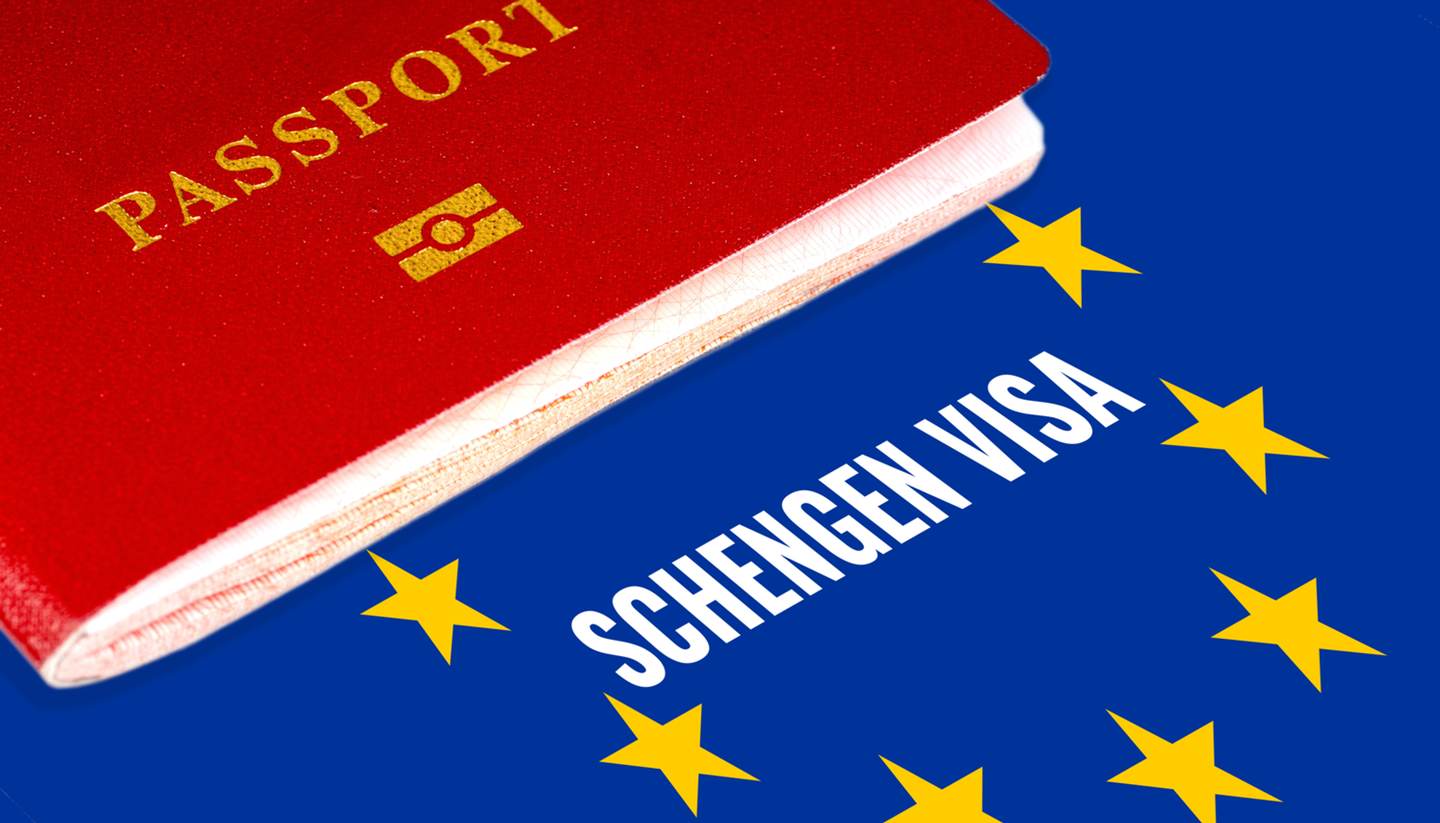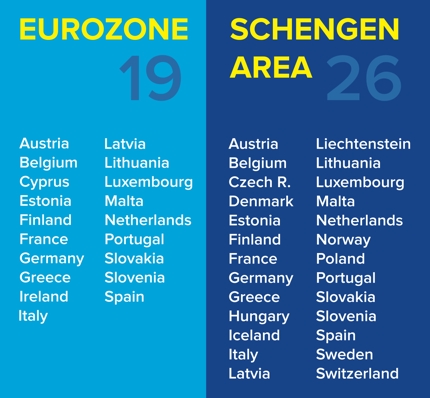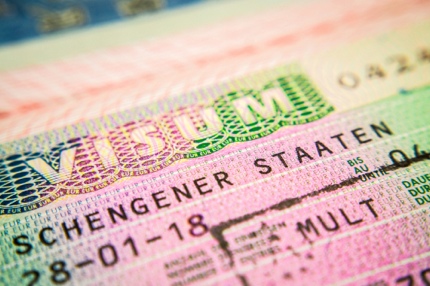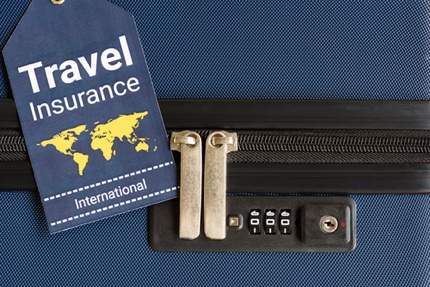A guide to Schengen visas, the costs, the application process and a full list of countries whose nationals must apply or are exempted
What are the Schengen visas?
The Schengen visas allow their holders to travel among 26 European countries on a single visa for up to 90 days in a 180-day period or to transit through the international airports of these countries. First signed in 1985, the Schengen Agreement was designed to open up Europe’s borders, making it easier for people to travel among member countries. Having said that, be aware that any of the Schengen countries can reintroduce temporary border control in response to current events.
The 26 countries, known collectively as the Schengen States, are Austria, Belgium, Czech Republic, Denmark, Estonia, Finland, France, Germany, Greece, Hungary, Iceland, Italy, Latvia, Liechtenstein, Lithuania, Luxembourg, Malta, Netherlands, Norway, Poland, Portugal, Slovakia, Slovenia, Spain, Sweden and Switzerland.
Among these 26, four of them, namely Iceland, Liechtenstein, Norway and Switzerland, are not part of the EU but are associate members of the Schengen Area.
In addition, there are four countries – Andorra, Monaco, San Marino and Vatican City – that aren’t part of the Schengen Area or European Union; but because they are enclosed within an EU country, they also follow the same rules and open their borders to visitors with a Schengen visa.
Schengen visa costs
From June 2024, Schengen visa costs €90 for those who are 12 years old and above, €45 for children aged six to 11, and free for children below six.
Nationals from Armenia and Azerbaijan pay a lower fee of €35.
In addition, the visa fee is waived for the following applicants:
- School pupils, students, postgraduate students and accompanying teachers who undertake stays for the purpose of study or educational training.
- Researchers from third countries travel for the purpose of carrying out scientific research.
- Representatives of non-profit organisations aged 25 years or less participating in seminars, conferences, sports, cultural or educational events organised by non-profit organisations.
- Family members of EU/EEA (European Economic Area) citizens, falling under Directive 2004/38.
Schengen visa validity
The precise length of validity of your visa is indicated on the visa sticker under the heading “Duration of visit”. In general, once issued, you can visit any of the Schengen countries for a stay of up to 90 days in any 180-day period.
The visa sticker under the heading “Number of entries” indicates how many times you can visit. If the number is ‘1’, it means it is a single-entry visa and you can only enter the Schengen area once. If the number is ‘2’, you can visit twice. If it is ‘MULT’, you can enter as many times as you want.
Application process
You must apply at the consulate of the country that you intend to visit, no more than six months before the start of your intended trip but no later than 15 calendar days before the intended trip.
If you plan to visit multiple countries, then you must use the main purpose of stay or longest stay to determine which consulate you must submit your application to. For example, if you plan to visit France, Spain and Italy as a tourist and you intend to stay in Italy longer than in the other two countries, then you must submit your application to the Italian consulate.
If you plan to visit multiple countries and spend an equal number of days in each one, then you must apply at the consulate of the country whose borders you cross first when entering the Schengen area.
The application process usually takes 15 calendar days. However, this is just a guide; in some instances, it may take up to 45 days. Be mindful of the national holidays of the country whose consulate you’re submitting your application to, as holidays can affect the processing time.
Documents required for a Schengen visa
The documents required for a Schengen visa include:
- A passport with at least two empty pages. The passport should have been issued within the last 10 years, have at least six months left, or at least three months beyond the date on which you intend to leave the Schengen Area, or, in the case of multiple journeys, the date on which you intend to leave after the last stay.
- A visa application, which you can download by following this link, then complete and sign. Use a separate application form for each person appearing in your passport. If the child is under 18, the application must be signed by a parent or a guardian.
- A recent identity photograph conforms to ICAO standards. You can see the accepted photos by following this link.
- Travel medical insurance covers emergency medical, hospitalisation and repatriation (including in case of death). The minimum cover should be €30,000. This insurance must be valid for the entire Schengen area and throughout the duration of the stay.
- Various documents relating to the purpose of your trip, including proof of accommodation and financial means.
- You will be asked to submit your fingerprints when applicable.
- Relevant visa fees.
Sometimes, the consulate may also ask for more information and expect you to submit further documents accordingly.
Schengen visa extension
In general, your Schengen visa cannot be extended once you have stayed 90 days in a 180-day period.
You may apply for an extension if you can show force majeure, or due to humanitarian reasons, or for serious personal reasons that make it impossible for you to leave a Schengen state before the expiry of your visa.
If your Schengen visa is rejected
If your Schengen visa is rejected, the consulate handling your application usually states the reasons for the refusal, along with an appeal process, should you choose to exercise it. Unfortunately, your visa fee is not refunded.
Who must apply for a Schengen visa?
Nationals from the following countries must apply for a Schengen visa before travelling:
Afghanistan, Algeria, Angola, Armenia, Azerbaijan, Bahrain, Bangladesh, Belarus, Belize, Benin, Bhutan, Bolivia, Botswana, Burkina Faso, Burundi, Cambodia, Cameroon, Cape Verde, Central African Republic, Chad, China, Comoros, Congo (Republic of), Congo (Democratic Republic of), Cote d’Ivoire (Ivory Coast), Cuba, Djibouti, Dominican Republic, Ecuador, Egypt, Equatorial Guinea, Eritrea, Eswatini (Swaziland), Ethiopia, Fiji, Gabon, Gambia, Ghana, Guinea, Guinea-Bissau, Guyana, Haiti, India, Indonesia, Iran, Iraq, Jamaica, Jordan, Kazakhstan, Kenya, Kosovo, Kuwait, Kyrgyzstan, Laos, Lebanon, Lesotho, Liberia, Libya, Madagascar, Malawi, Maldives, Mali, Mauritania, Mongolia, Morocco, Mozambique, Myanmar, Namibia, Nauru, Nepal, Niger, Nigeria, North Korea, Oman, Pakistan, Palestinian Territories, Papua New Guinea, Philippines, Qatar, Russia, Rwanda, Sao Tome and Principe, Saudi Arabia, Senegal, Sierra Leone, Somalia, South Africa, South Sudan, Sri Lanka, Sudan, Suriname, Syria, Tajikistan, Tanzania, Thailand, Togo, Tunisia, Turkey, Turkmenistan, Uganda, Uzbekistan, Vietnam, Yemen, Zambia and Zimbabwe.
Who is exempted from a Schengen visa?
At present, nationals from 59 countries or territories can visit any of the Schengen countries for up to 90 days in a 180-day period without a visa.
These countries or territories are Albania, Antigua and Barbuda, Argentina, Australia, Bahamas, Barbados, Bosnia and Herzegovina, Brazil, Brunei, Canada, Chile, Colombia, Costa Rica, Dominica, El Salvador, Georgia, Grenada, Guatemala, Honduras, Hong Kong, Israel, Japan, Kiribati, Macao, Malaysia, Marshal Islands, Mauritius, Mexico, Micronesia, Moldova, Montenegro, New Zealand, Nicaragua, North Macedonia, Palau, Panama, Paraguay, Peru, Saint Kitts and Nevis, Saint Lucia, Saint Vincent and the Grenadines, Samoa, Serbia, Seychelles, Singapore, Solomon Islands, South Korea, Timor-Leste, Tonga, Trinidad and Tobago, Tuvalu, Ukraine, United Arab Emirates, United Kingdom, United States of America, Uruguay, Vanuatu and Venezuela.
* Hong Kong and Macao: holders of SAR passports do not need a visa.
* Taiwan: holders of passports issued by Taiwan which include an identity card number do not need a visa.
* Serbia: holders of biometric passports do not need a visa, excluding holders of passports issued by the Serbian Coordination Directorate.
* Vanuatu: holders of passports issued on or after 25 May 2015 do not need a visa.
Schengen airport transit visa
A Schengen airport transit visa allows affected travellers to transit through the international parts of the airports in any Schengen country and continue the journey to a non-Schengen destination country.
If you are uncertain if you need one, check directly with the airlines handling your booking or the consulate whose country you’re transiting.
You may be exempt from the airport transit visa requirement if you:
- Hold a valid visa or residence permit issued by a Schengen state
- Hold a valid visa for a Member State of the EU, EEA (European Economic Area), Canada, Japan or the United States
- Hold a valid residence permit issued by a Member State of the EU or EEA
- Hold a residence permit issued by the Principality of Andorra, Canada, Japan, Republic of San Marino, or the United States, that guarantees unrestricted right of return
- Hold a diplomatic passport
- You’re a family member of a citizen of the EU, EEA or Switzerland
- You’re a flight crew member and national of a contracting party to the Chicago Convention on International Civil Aviation
Did you know?
The name Schengen originates from the small town in Luxembourg where the agreement was first signed.
You may also like:
- Central European historic spas and resorts
- Exploring Northern Ireland’s coastal route
- 22 reasons why you should fall in love with Estonia
- The 10 most scenic self-guided walking holidays in England
- The complete guide to smoking marijuana in Amsterdam coffeeshops
- Applying for ETIAS
This article was first published in June 2018 and updated on 18 August 2022.










